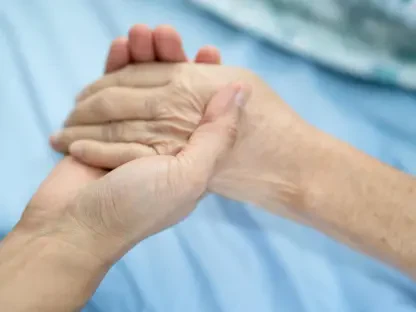The critical issue of women being overlooked in the diagnosis, treatment, and research of cardiovascular diseases (CVDs) is more pressing than ever. A consensus statement published in the journal Heart by Newcastle University’s Professor Vijay Kunadian and various UK cardiovascular, nursing, and patient organizations associated with the British Cardiovascular Society aims to address these unmet needs. The statement seeks to ensure equitable care and improve health outcomes for women globally, who are disproportionately affected by CVDs due to unique biological, cultural, and societal factors.
One of the primary issues raised in the statement is the inadequate management of standard cardiovascular risk factors, such as high blood pressure and high cholesterol, in women. Despite accounting for half of all preventable cardiovascular deaths, these risk factors are not as effectively managed in women compared to men, leading to higher post-heart attack mortality rates in women. This discrepancy is further exacerbated by the prevalent misconception that heart disease is predominantly a men’s issue. Consequently, there is often a gender bias in immediate medical responses, leading to delayed or sub-optimal care for women experiencing cardiovascular events.
Unique Challenges Women Face
Biological and Physiological Differences
Women’s biology and physiology significantly impact their susceptibility to CVD and the effectiveness of diagnostics and treatments. The hormonal changes women undergo, particularly during menopause, significantly increase their risk of developing CVD. Additionally, women are more likely to experience non-traditional symptoms of heart attacks, such as fatigue, shortness of breath, and nausea, rather than the classic chest pain more commonly reported by men. These differences can lead to misdiagnosis or delayed diagnosis in women, further contributing to higher mortality rates.
Moreover, women tend to develop coronary artery disease at a later age compared to men, and their smaller artery size can complicate procedures such as angioplasty and stent placement. The statement highlights the need for healthcare providers to acknowledge these biological and physiological differences when diagnosing and treating women with CVD. By understanding these unique challenges, clinicians can offer more tailored and effective interventions, improving overall outcomes for female patients.
Cultural, Societal, and Financial Barriers
Women also face numerous cultural, societal, and financial barriers that increase their risk of heart disease and limit their access to appropriate care. For instance, women often prioritize the health and well-being of their families over their own, leading to delayed medical attention for themselves. Furthermore, societal norms and expectations can contribute to the underestimation of their cardiovascular risk. Financial barriers, such as lower income levels and lack of health insurance, further exacerbate these challenges, making it difficult for women to access timely and specialized cardiac care.
Addressing these barriers requires a multifaceted approach that includes raising public awareness about women’s cardiovascular risk, promoting gender equity in healthcare, and ensuring that women have equal access to resources and support. By tackling these cultural, societal, and financial obstacles, we can create a more inclusive and supportive healthcare environment for women, ultimately reducing the gender disparity in cardiovascular outcomes.
Recommended Actions and Solutions
Raising Awareness and Ensuring Inclusion
Several key actions have been recommended to address the unmet needs and disparities in cardiovascular care for women. One of the primary actions is raising awareness of both traditional and women-specific cardiovascular risk factors through public health campaigns and education initiatives. This involves informing the public that coronary artery disease is the leading cause of death among women and emphasizing the importance of early detection and management of risk factors.
Additionally, ensuring women’s inclusion in cardiovascular research is crucial for improving their health outcomes. Historically, women have been under-represented in clinical trials, leading to a lack of data on the efficacy of various treatments for female patients. By advocating for the inclusion of women in research studies, we can generate more accurate and comprehensive data, ultimately leading to better treatment options and outcomes for women with CVD.
Improving Clinical Practices and Training
Enhancing clinician awareness of the strengths and limitations in diagnosing and treating CVD in women is another critical step in addressing the gender disparity. This involves providing healthcare professionals with training and resources to better understand the unique cardiovascular risk factors and symptoms experienced by women. By equipping clinicians with this knowledge, we can improve the accuracy of diagnoses and the effectiveness of treatments for female patients.
Furthermore, it is essential to make women’s cardiovascular health a primary responsibility for primary care clinicians. This can be achieved through regular screening for cardiovascular risk factors and ensuring that women have access to specialized cardiac care when needed. Additionally, increasing women’s participation in cardiac rehabilitation programs, such as hybrid or virtual sessions, can help them recover more effectively after cardiovascular events and reduce the risk of future complications.
Advocacy and Holistic Approaches
Engaging Patients and Advocates
Patients and advocates play a vital role in addressing the gender disparities in cardiovascular care by promoting a holistic, female-centered approach to heart health. This includes engaging media to raise awareness, customizing information for women, and highlighting women-specific heart conditions. By co-designing training programs for healthcare professionals, patients and advocates can ensure that the unique needs and experiences of women are adequately represented and addressed in clinical practice.
Proposals such as creating women’s heart champions for peer support and establishing dedicated women’s heart hubs can further enhance the support available for women with CVD. These heart hubs can focus on monitoring risk factors, providing lifestyle advice, and offering ongoing support to help women manage their cardiovascular health effectively.
Developing Comprehensive Health Strategies
Developing a comprehensive women’s health strategy is crucial for addressing the gender disparities in cardiovascular care. This strategy should include efforts to combat gender biases in healthcare, ensure equal access to genetic testing and family screening, and address the under-representation of women in clinical trials, particularly for new cancer treatments. Establishing registries to track cardiac toxicity from cancer chemotherapy, with a focus on women, can also help identify and mitigate potential risks for female patients.
By implementing these recommendations and fostering a holistic, female-centered approach to cardiovascular care, we can significantly improve health outcomes for women. Addressing the unique challenges faced by women and ensuring their inclusion in research and clinical practice will ultimately lead to more equitable and effective healthcare solutions for all patients.
A Path Towards Equitable Cardiovascular Care
Shifting Mindsets and Improving Awareness
To achieve meaningful improvements in women’s cardiovascular health, it is essential to shift mindsets and improve awareness about the unique challenges faced by women in this area. This involves acknowledging the gender biases that exist in healthcare and working towards a more inclusive and equitable system. By prioritizing education and awareness campaigns, we can help change public perception and encourage women to take their heart health seriously.
Additionally, healthcare professionals must be proactive in recognizing and addressing the unique cardiovascular risk factors and symptoms experienced by women. This requires continuous learning and adaptation to ensure that the standard of care provided to women is on par with that of men. By fostering a culture of inclusivity and equity within the healthcare system, we can ensure that women receive the care they need to prevent and manage cardiovascular diseases effectively.
Implementing Strategic Actions
The pressing issue of women being overlooked in the diagnosis, treatment, and research of cardiovascular diseases (CVDs) needs immediate attention. A consensus statement in the journal Heart, authored by Newcastle University’s Professor Vijay Kunadian and supported by multiple UK cardiovascular, nursing, and patient organizations linked with the British Cardiovascular Society, addresses these gaps. This statement aims to ensure fair treatment and improve the health outcomes for women globally. Women are disproportionately impacted by CVDs due to unique biological, cultural, and societal factors.
A major concern highlighted is the inadequate management of standard cardiovascular risk factors like high blood pressure and high cholesterol in women. Despite these factors contributing to half of all preventable cardiovascular deaths, they are less effectively managed in women compared to men, resulting in higher post-heart attack mortality rates. This is compounded by the misconception that heart disease is mainly a men’s issue, leading to gender bias in immediate medical responses and delayed or sub-optimal care for women during cardiovascular events.









